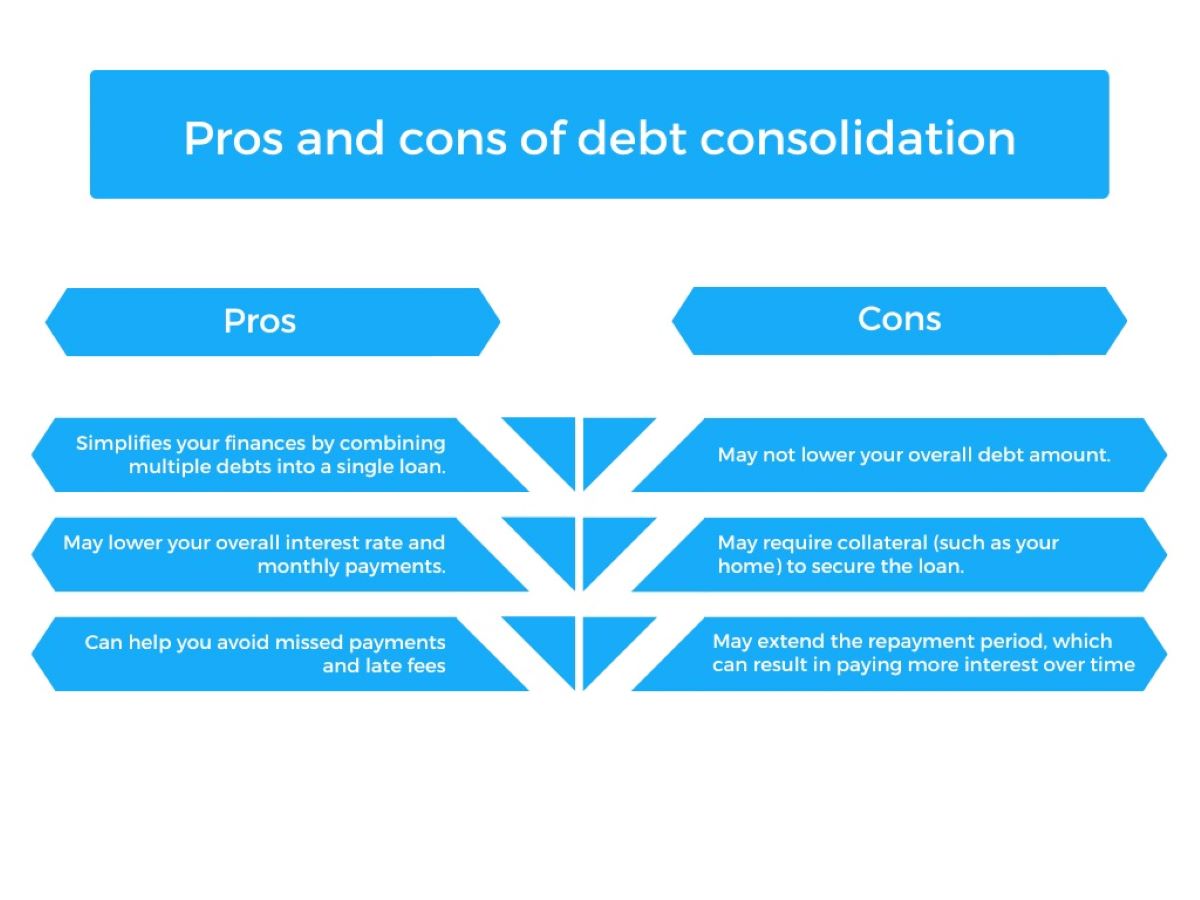

Finance
What Is Consolidation In Accounting
Published: October 12, 2023
Learn what consolidation is in accounting and how it affects the financial aspects of a business. Stay informed about finance and improve your accounting knowledge.
(Many of the links in this article redirect to a specific reviewed product. Your purchase of these products through affiliate links helps to generate commission for LiveWell, at no extra cost. Learn more)
Table of Contents
Introduction
Welcome to the world of accounting consolidation. In the realm of finance and accounting, consolidation is a crucial concept that plays a significant role in presenting the financial performance and position of a company accurately. It involves combining the financial statements of subsidiaries or affiliate companies into a single set of financial statements for the parent company. Consolidation is an essential process for large corporations with multiple subsidiaries, allowing them to provide a comprehensive overview of their financials and ensure transparency in reporting.
In simple terms, consolidation in accounting refers to the method of aggregating financial information from different entities within a corporate structure to present a consolidated or combined financial statement. This consolidated statement provides a holistic view of the financial health and performance of the entire group, rather than assessing individual entities in isolation.
The process of consolidation takes into account the ownership and control relationship between the parent company and its subsidiaries. It consolidates the assets, liabilities, revenues, expenses, and equity of all the entities involved, resulting in a consolidated balance sheet, income statement, cash flow statement, and statement of changes in equity.
The consolidation process is essential for stakeholders, including shareholders, investors, analysts, and regulators, as it provides a clearer picture of the overall financial position and performance of the entire corporate group. It enables them to make informed decisions, assess risk levels, and evaluate the company’s ability to generate profits and manage its financial obligations.
Consolidation also takes into account the impact of intercompany transactions, such as sales, purchases, loans, and capital contributions, which can have significant implications on the financial statements. By eliminating these intercompany transactions, consolidation eliminates any double-counting or distortion in the financial figures.
Overall, consolidation in accounting is a vital process that ensures transparency, accuracy, and comparability of financial information. It allows companies to present a comprehensive view of their finances, making it easier for stakeholders to evaluate their performance and make informed decisions. In the following sections, we will delve deeper into the various aspects of consolidation and explore its benefits and challenges in more detail.
Definition of Consolidation in Accounting
Consolidation in accounting refers to the process of combining the financial statements of subsidiary companies into a single consolidated financial statement. It involves aggregating the assets, liabilities, revenues, expenses, and equity of all entities within a corporate group to create a comprehensive view of the financial performance and position of the entire group.
When a company owns a controlling interest in another company, generally defined as owning more than 50% of the subsidiary’s voting shares, they are required to consolidate the subsidiary’s financial information with their own. This allows for a more accurate representation of the parent company’s financial standing and performance, as well as a consolidated view of the group as a whole.
The process of consolidation begins by gathering the individual financial statements of each subsidiary company. These statements include the balance sheet, income statement, cash flow statement, and statement of changes in equity. The financial statements are then adjusted to eliminate any intercompany transactions, which can mask the true financial position of the group.
Once the individual financial statements have been adjusted, they are combined into a single set of consolidated financial statements. The consolidated financial statements typically include a consolidated balance sheet, income statement, cash flow statement, and statement of changes in equity. These statements provide a comprehensive overview of the group’s financial performance and position, and are crucial for accurate reporting and decision-making.
Consolidation in accounting is not only applicable to subsidiaries, but it can also involve the consolidation of other entities, such as joint ventures and associates, depending on the level of influence or control held by the parent company. The level of control is determined by factors such as voting rights, board representation, and participation in the decision-making process.
It is important to note that consolidation is distinct from the concept of equity method accounting, which is used when a parent company does not have full control over a subsidiary but has a significant influence. In equity method accounting, the parent company recognizes its share of the subsidiary’s profits or losses as a single line item in the parent company’s financial statements.
In summary, consolidation in accounting is the process of combining the financial information of subsidiary companies into a single set of consolidated financial statements. This process provides a comprehensive view of the financial performance and position of the entire corporate group, ensuring accuracy, transparency, and comparability of financial information.
Purpose of Consolidation in Accounting
The purpose of consolidation in accounting goes beyond simply presenting a consolidated financial statement. It serves several important objectives that are essential for accurate financial reporting and decision-making. Understanding these purposes is crucial to grasp the significance of consolidation in the accounting world.
1. Provide a comprehensive view: The primary purpose of consolidation is to provide stakeholders with a holistic view of the financial performance and position of the entire corporate group. Combining the financial statements of subsidiaries into a single consolidated statement allows investors, shareholders, and other stakeholders to understand the overall financial health and performance of the company better.
2. Eliminate intercompany transactions: Consolidation ensures that intercompany transactions, such as sales, purchases, loans, and capital contributions between the parent company and its subsidiaries, are appropriately accounted for. By eliminating these transactions, consolidation eliminates any double-counting or distortion in the financial figures, presenting a more accurate representation of the group’s financials.
3. Assess group performance: Consolidation enables the assessment of the group’s overall financial performance. It allows stakeholders to evaluate the profitability, revenue generation, and cost management across all entities in the group. This comprehensive view is particularly useful for analyzing the effectiveness of corporate strategies and identifying areas for improvement.
4. Facilitate decision-making: Consolidated financial statements aid decision-making by providing a clear and complete picture of the group’s financial position. Investors and shareholders can use this consolidated information to evaluate the financial stability and growth prospects of the company. It also helps management make informed decisions about resource allocation, investment opportunities, and potential risks.
5. Ensure compliance with accounting standards: Consolidation is a requirement under accounting standards, especially for companies that have a controlling interest in subsidiaries. Complying with these standards ensures that the financial statements are prepared according to generally accepted accounting principles (GAAP) or international financial reporting standards (IFRS), enhancing the credibility and comparability of the financial information.
6. Enhance transparency and accountability: Consolidation promotes transparency by providing a comprehensive view of the group’s financials, including any potential risks and obligations. It enhances accountability by compelling companies to disclose all relevant financial information, allowing stakeholders to hold management accountable for their financial decisions and performance.
7. Facilitate valuation: Consolidated financial statements are crucial for the valuation of the company. When determining the value of a company, potential investors or acquirers consider the consolidated financial statements, which provide a more accurate representation of the group’s financial worth. It helps in understanding the assets, liabilities, and overall financial health of the group, influencing the valuation process.
In summary, the purpose of consolidation in accounting is to provide a comprehensive view of the group’s financial performance and position. It eliminates intercompany transactions, aids in decision-making, ensures compliance with accounting standards, enhances transparency and accountability, and facilitates valuation. By achieving these objectives, consolidation plays a crucial role in accurate financial reporting and informed decision-making within the corporate world.
Consolidation Methods
There are different consolidation methods employed in accounting, each with its own approach to combining the financial statements of subsidiary companies. The choice of consolidation method depends on the level of control or influence the parent company has over its subsidiaries. Let’s explore the three main consolidation methods:
- Full Consolidation: Full consolidation, also known as the acquisition method, is used when the parent company has a controlling interest in the subsidiary, usually defined as owning more than 50% of the subsidiary’s voting shares. Under this method, the assets, liabilities, revenues, expenses, and equity of the subsidiary are fully consolidated with those of the parent company. The financial statements of the subsidiary are adjusted to conform to the accounting policies and standards of the parent company. This method provides the most comprehensive view of the group’s financial position and performance.
- Equity Method: The equity method is used when the parent company has significant influence but not full control over the subsidiary. Significant influence is generally defined as owning between 20% and 50% of the subsidiary’s voting shares. With the equity method, the parent company recognizes its share of the subsidiary’s profits or losses as a single line item in the parent company’s financial statements. This method is used to reflect the economic substance of the parent-subsidiary relationship while acknowledging that control rests with other investors.
- Proportional Consolidation: Proportional consolidation is a less commonly used method that represents a proportionate share of each subsidiary’s assets, liabilities, revenues, and expenses in the consolidated financial statements. It is typically used when the parent company has joint control over a subsidiary, meaning that decision-making authority is shared with other parties. Proportional consolidation is less prevalent since it has largely been replaced by the equity method in accounting standards.
It’s important to note that the choice of consolidation method impacts the presentation of the consolidated financial statements and the recognition of intercompany transactions. Each method has its own advantages and limitations, and the selection should align with the specific circumstances and requirements of the parent company and its subsidiaries.
Regardless of the consolidation method used, the objective remains the same – to present a consolidated financial statement that provides an accurate and comprehensive view of the financial position and performance of the entire corporate group.
Key Consolidation Terms
When dealing with consolidation in accounting, there are several key terms that you should be familiar with. These terms help to understand the intricacies of the consolidation process and the various elements involved. Let’s explore some of the important consolidation terms:
- Parent Company: The parent company, also known as the holding company or controlling entity, is the company that has control over one or more subsidiary companies. It owns a majority of the voting shares of the subsidiary and consolidates their financial information into its own financial statements.
- Subsidiary: A subsidiary is a company that is controlled by another entity, known as the parent company. The parent company holds a majority of the voting shares of the subsidiary, allowing it to exercise control over the subsidiary’s operations and financial decisions. The financial statements of the subsidiary are consolidated with those of the parent company.
- Controlling Interest: Controlling interest refers to the ownership stake that gives the parent company the power to influence the financial and operating policies of the subsidiary. It is typically defined as ownership of more than 50% of the subsidiary’s voting shares. Companies with controlling interest are required to consolidate the subsidiary’s financial information.
- Non-controlling Interest (NCI): Non-controlling interest, also known as minority interest, represents the portion of a subsidiary’s equity that is not owned by the parent company. It reflects the ownership interests of other shareholders or investors in the subsidiary. Non-controlling interest is reported separately in the consolidated financial statements to distinguish it from the equity of the parent company.
- Intercompany Transactions: Intercompany transactions are transactions that occur between the parent company and its subsidiaries. These transactions can include sales, purchases, loans, dividends, and other financial activities. When preparing consolidated financial statements, intercompany transactions are eliminated to prevent double-counting or distortion of the financial figures.
- Elimination Entries: Elimination entries are journal entries made to remove the effects of intercompany transactions from the consolidated financial statements. These entries ensure that the financial statements reflect the financial position and performance of the group as a whole, rather than the individual entities within the group.
- Consolidated Financial Statements: Consolidated financial statements are financial statements that combine the financial information of the parent company and its subsidiaries. These statements include a consolidated balance sheet, income statement, cash flow statement, and statement of changes in equity. They provide a comprehensive view of the financial performance and position of the entire corporate group.
Understanding these key consolidation terms is essential for navigating the world of consolidation in accounting. These terms capture the relationships, ownership structures, and financial activities that are integral to the consolidation process. By familiarizing yourself with these terms, you will have a solid foundation for comprehending and effectively utilizing consolidation concepts in accounting.
Benefits of Consolidation in Accounting
Consolidation in accounting offers several benefits that are instrumental in enhancing financial reporting, decision-making, and overall transparency within a corporate group. Let’s explore some of the key advantages of consolidation:
- Comprehensive Financial Reporting: Consolidation allows companies to present a comprehensive view of their financial performance and position. By combining the financial statements of subsidiary companies, stakeholders can gain a clearer understanding of the overall financial health of the entire corporate group. This comprehensive reporting aids in assessing profitability, liquidity, and the overall financial stability of the group.
- Accuracy and Transparency: Consolidation ensures accuracy and transparency in financial reporting by eliminating intercompany transactions. These transactions could otherwise distort the financial figures by double-counting, inflating revenues, or understating expenses. By eliminating these transactions, consolidation provides a more accurate and transparent view of the financials, reducing confusion and misinterpretation.
- Investor Confidence: Transparent and accurate financial reporting through consolidation can enhance investor confidence. Potential investors looking to invest in the parent company or acquire the group as a whole have access to consolidated financial statements that provide a comprehensive and reliable overview of the group’s financial performance and position. This helps investors make informed decisions and evaluate the potential risks and rewards associated with the investment.
- Improved Decision-Making: Consolidated financial statements assist management in making informed decisions about resource allocation, capital investment, and strategic planning. By having a consolidated view of the entire corporate group, management can identify areas of strength and weakness, evaluate profitability and cash flow, and allocate resources effectively across various subsidiaries. This consolidated information provides crucial insights for strategic decision-making.
- Enhanced Risk Assessment: Consolidation aids in assessing the financial risks associated with the corporate group. By analyzing the consolidated financial statements, stakeholders can identify potential vulnerabilities, exposure to market risks, and the financial resilience of the group. This enables them to implement appropriate risk management strategies and proactively address potential challenges.
- Compliance with Accounting Standards: Consolidation is often a requirement under accounting standards, ensuring compliance and adherence to reporting regulations. By consolidating the financial statements of subsidiaries, companies can meet the accounting principles and standards set by the regulatory bodies. This compliance enhances the credibility, comparability, and consistency of financial information, making it easier for stakeholders to assess and evaluate the group’s financial performance.
- Economies of Scale: Consolidation facilitates the identification and realization of economies of scale within the corporate group. By bringing together the resources, capabilities, and operations of multiple entities, companies can achieve cost efficiencies, optimize procurement processes, and streamline operations. This can lead to cost savings, improved profitability, and increased competitiveness in the market.
Overall, consolidation in accounting offers a range of benefits, such as comprehensive financial reporting, accuracy, transparency, investor confidence, improved decision-making, enhanced risk assessment, compliance with accounting standards, and economies of scale. By leveraging these benefits, companies can enhance their financial reporting integrity, optimize resource allocation, and drive growth within the corporate group.
Challenges of Consolidation in Accounting
While consolidation in accounting provides numerous benefits, it also poses certain challenges that companies must navigate to ensure accurate and meaningful financial reporting. Let’s explore some of the key challenges associated with consolidation:
- Complexity of Intercompany Transactions: Intercompany transactions between the parent company and its subsidiaries can be complex to account for accurately. Determining fair values, eliminating intercompany profits or losses, and properly recording these transactions require careful analysis and attention to detail.
- Differing Accounting Policies: Subsidiaries may adopt different accounting policies or principles, which can complicate the consolidation process. Harmonizing these policies and ensuring consistency across the group can be challenging and time-consuming, especially when dealing with subsidiaries operating in different jurisdictions.
- Consolidation Adjustments: Consolidation involves making various adjustments to the financial statements of subsidiaries, including eliminating unrealized gains/losses on intercompany transactions and adjusting for depreciation, amortization, and fair value. These adjustments can be complex and require a deep understanding of accounting standards and principles.
- Consolidation Timeframes: Consolidation necessitates gathering financial information from multiple entities within the group and making necessary adjustments. This process can be time-consuming, particularly for large organizations with numerous subsidiaries, and may result in delays in financial reporting.
- Integration Challenges: Consolidating different systems, processes, and financial data from various subsidiaries can present integration challenges. Differences in accounting systems or practices, as well as issues related to data quality and integrity, can complicate the consolidation process and impact the accuracy of the consolidated financial statements.
- Multinational Considerations: For multinational corporations with subsidiaries operating in different countries, consolidation presents additional challenges. Dealing with variations in foreign currency translations, complying with local accounting regulations, and reconciling financial statements across different jurisdictions can add complexity to the consolidation process.
- Non-controlling Interests (NCI): Accounting for non-controlling interests, also known as minority interests, in the consolidated financial statements can be challenging. Determining the appropriate treatment of NCI, calculating their share of profits or losses, and reporting their equity accurately require careful analysis and adherence to accounting guidelines.
- Reporting Accuracy: Consolidating financial statements requires a high level of accuracy to reflect the true financial position and performance of the group. Errors in consolidation calculations, omissions in intercompany transactions, or misinterpretation of accounting standards can result in misleading or inaccurate financial reporting.
Addressing these challenges requires a deep understanding of accounting standards, attention to detail, and a robust consolidation process. Companies must invest in skilled accounting professionals, establish effective data management systems, and maintain open communication between the parent company and its subsidiaries to ensure successful consolidation and accurate financial reporting.
Despite the challenges, consolidation remains an essential process for providing a comprehensive view of a company’s financial performance and position. By identifying and addressing these challenges, companies can strengthen their consolidation processes and enhance the accuracy, transparency, and reliability of their consolidated financial statements.
Examples of Consolidation in Accounting
To illustrate the concept of consolidation in accounting, let’s explore a couple of examples that showcase how the financial statements of subsidiary companies are combined to present consolidated financial information:
- Example 1: Parent Company and Subsidiary: Company XYZ is a multinational corporation that owns a controlling interest in Company ABC, a subsidiary operating in a different country. Company XYZ consolidates the financial statements of Company ABC with its own financial statements. This involves gathering the individual financial statements of both companies, eliminating intercompany transactions such as sales or loans, and adjusting for any differences in accounting policies. The combined financial information is then presented in the consolidated financial statements of Company XYZ, providing stakeholders with a comprehensive view of the group’s financial performance and position.
- Example 2: Complex Corporate Structure: Company A is a large conglomerate with multiple subsidiaries across various industries. Some of the subsidiaries are fully owned by Company A, while others are partially owned through joint ventures or have minority shareholders. To prepare consolidated financial statements, Company A gathers the financial statements of all its subsidiaries. For fully owned subsidiaries, a full consolidation method is used, where their financials are fully incorporated into Company A’s financial statements. The equity method is used for partially owned subsidiaries, reflecting their proportionate share of profits or losses. Non-controlling interests (NCI) are reported separately to represent minority shareholders’ ownership. After making necessary adjustments and eliminations for intercompany transactions, Company A presents consolidated financial statements to provide a comprehensive view of the financial performance and position of the entire corporate group.
These examples demonstrate how consolidation in accounting allows companies to combine the financial information of subsidiary companies to present a consolidated view of the group’s financials. The process involves adjusting for intercompany transactions, harmonizing accounting policies, and applying specific consolidation methods based on the level of control or influence over subsidiaries.
Consolidation is crucial for providing stakeholders with accurate and comprehensive financial information, aiding decision-making, and ensuring compliance with accounting standards. It allows companies to present a holistic view of their financial performance, making it easier for investors, shareholders, and other stakeholders to assess the overall financial health and position of the corporate group.
Conclusion
Consolidation in accounting plays a critical role in the financial reporting and decision-making processes of companies with subsidiaries or affiliate entities. By combining the financial statements of these entities, consolidation provides a comprehensive view of a corporate group’s financial performance and position. It ensures accuracy, transparency, and comparability of financial information, enabling stakeholders to make informed decisions and evaluate the overall health of the company.
Throughout this article, we have explored the definition of consolidation, its purpose, various consolidation methods, key consolidation terms, and the benefits and challenges associated with consolidation in accounting. We have seen that consolidation enables companies to present consolidated financial statements that eliminate intercompany transactions, provide a holistic view of the group’s performance, and comply with accounting standards.
The benefits of consolidation are numerous – it enhances financial reporting integrity, fosters transparency and investor confidence, facilitates better decision-making, and allows for risk assessment and compliance. However, consolidation does come with challenges, such as dealing with complex intercompany transactions, reconciling differing accounting policies, and ensuring reporting accuracy.
Nonetheless, by addressing these challenges, companies can strengthen their consolidation processes and improve the accuracy and reliability of the consolidated financial statements. Investing in skilled accounting professionals, establishing effective data management systems, and maintaining open communication between parent companies and subsidiaries are vital to successful consolidation.
In summary, consolidation in accounting is a fundamental process that provides a comprehensive view of a company’s financials by combining the financial statements of subsidiaries or affiliate entities. It contributes to accurate financial reporting, aids in decision-making, and increases transparency and accountability within corporate groups. To ensure the effectiveness of consolidation, companies must navigate the challenges while leveraging the benefits to drive financial performance and meet the expectations of stakeholders.














